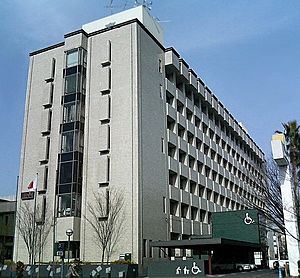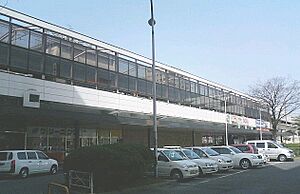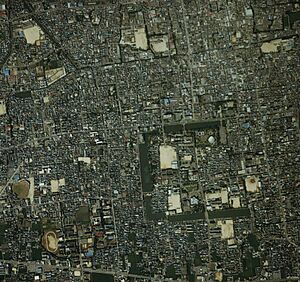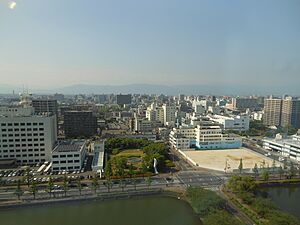Saga (city) facts for kids
Quick facts for kids
Saga
佐賀市
|
|||
|---|---|---|---|
| Saga City | |||

Top:Saga International Balloon Fiesta. Second:Saga Castle, A heritage site of Mietsu Naval Dock, Third:Furuyu Spa, Saga Historial Folk Museum, Bottom:Saga Shrine, (all item from left to right)
|
|||
|
|||
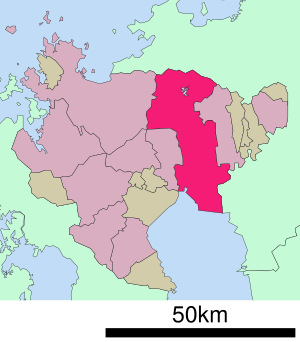
Location of Saga in Saga Prefecture
|
|||
| Country | |||
| Region | Kyushu | ||
| Prefecture | Saga | ||
| Area | |||
| • Total | 431.81 km2 (166.72 sq mi) | ||
| Population
(April 30, 2024)
|
|||
| • Total | 227,138 | ||
| • Density | 526.014/km2 (1,362.369/sq mi) | ||
| Time zone | UTC+9 (Japan Standard Time) | ||
| - Tree | Ginkgo | ||
| - Flower | Cherry blossom (sakura) | ||
| Address | 1-1 Sakaemachi, Saga-shi, Saga-ken 840-8501 | ||
Saga (佐賀市, Saga-shi) is the main city of Saga Prefecture in Japan. It's located on the island of Kyushu. As of April 2024, about 227,138 people live here. The city covers an area of 431.81 square kilometers.
Contents
Exploring Saga's Geography
Saga City is in the southeast part of Saga Prefecture. It stretches from north to south. To the south, it touches the Ariake Sea. To the southeast and north, it borders Fukuoka Prefecture.
Mountains and Plains
The northern part of Saga City is mountainous. These are the Sefuri Mountains. They are part of a larger mountain range in northern Kyushu. The southern part of the city is a flat area called the Saga Plain. This plain is very low-lying. The main city area is in the middle of this plain.
Neighboring Cities and Towns
Saga City shares borders with several other places.
* Fukuoka * Itoshima * Ōkawa * Sawara-ku, Fukuoka * Yanagawa
- In Saga Prefecture:
* Kanzaki * Karatsu * Ogi * Taku
Saga's Climate
Saga has a humid subtropical climate. This means it has hot, humid summers and mild winters. The city center gets about 1800 mm (71 inches) of rain each year. The average temperature in the city center is about 17 °C (63 °F).
Saga's Population Over Time
The number of people living in Saga has changed over the years. Here's how the population has looked according to Japanese census data:
| Historical population | ||
|---|---|---|
| Year | Pop. | ±% |
| 1940 | 198,243 | — |
| 1950 | 206,639 | +4.2% |
| 1960 | 215,000 | +4.0% |
| 1970 | 236,029 | +9.8% |
| 1980 | 243,726 | +3.3% |
| 1990 | 243,076 | −0.3% |
| 2000 | 237,501 | −2.3% |
| 2010 | 237,506 | +0.0% |
| 2020 | 233,301 | −1.8% |
A Look at Saga's History
People have lived in the Saga area since ancient times. This includes the Jōmon period and Yayoi period. Long ago, it was part of Hizen Province.
From Castle Town to Modern City
During the Sengoku period (a time of wars), the Ryūzōji clan ruled this area. Later, in 1608, the Nabeshima clan took control. They became the daimyō (feudal lords) of Saga Domain. Saga was once a small town known for water travel and farming. It grew into a busy castle town after Saga Castle was built.
Because Saga was close to Nagasaki, it learned a lot about Western science and technology. This made Saga an important place during the Bakumatsu period. It played a big role in the Meiji restoration, which brought major changes to Japan.
How Saga City Grew
- April 1, 1889: Saga City was officially founded. Many villages were around it at this time.
- October 1, 2005: Several towns and a village merged with Saga. This made the city much larger.
- October 1, 2007: More towns joined Saga. This made Saga District disappear.
Saga's Economy and Industries
Saga's economy has a mix of farming, fishing, and other industries.
Farming and Fishing
In the areas around the city, farmers grow grains. Fishing is also important, especially seaweed cultivation in the Ariake Sea.
Changing Industries
Saga was once a big rice-growing area. Now, many farms grow vegetables instead. Heavy industries, like big factories, haven't developed much here. This is because the Ariake Sea is shallow, so large ships can't easily reach the city.
In the early 1900s, coal mining was important. Later, the food and textile industries grew. While the food industry is still strong, the textile industry has become less important since the 1970s. Since the 1990s, the car parts industry has been growing. This is because many car and parts companies are in northern Kyushu.
Services and Business
As the capital of the prefecture, Saga has many jobs in the service industry. This includes shops, restaurants, and other services. Many companies have their main offices in Saga.
Learning in Saga: Schools and Universities
Saga City has many schools and colleges for students of all ages.
Colleges and Universities
- Nishikyushu University Junior College
- Saga University
- Saga Women's Junior College
Primary and Secondary Education
The city has 35 public elementary schools and 18 public junior high schools. There are also private junior high schools. For older students, there are six public high schools and several private high schools.
Getting Around Saga: Transportation
Saga has different ways to travel, including an airport, trains, and highways.
Airports
- Saga Airport is located nearby. Before it opened, people used Fukuoka Airport. Many still use Fukuoka Airport because it has more flights. There's a bus that connects the two airports.
Railway Travel
You can travel by train in Saga using the JR Kyushu lines.
- Nagasaki Main Line: This line has stations like Igaya, Saga, Nabeshima, and Balloon Saga. Balloon Saga station is only open during the Saga International Balloon Fiesta.
- Karatsu Line: This line connects to Kubota station.
Major Highways
Several highways pass through or near Saga City, making it easy to travel by car.
 Nagasaki Expressway
Nagasaki Expressway National Route 34
National Route 34 National Route 207
National Route 207 National Route 208
National Route 208 National Route 263
National Route 263 National Route 264
National Route 264 National Route 323
National Route 323 National Route 444
National Route 444
Saga's Sister Cities
Saga City has special friendships with cities around the world. These are called sister cities.
 Cussac-Fort-Médoc, France
Cussac-Fort-Médoc, France Glens Falls, New York, United States (since 1988)
Glens Falls, New York, United States (since 1988) Lianyungang, China
Lianyungang, China Warren County, New York, United States (since 1988)
Warren County, New York, United States (since 1988) Yeonje District, South Korea
Yeonje District, South Korea
Fun Places to Visit in Saga
Saga has many interesting places to explore, from historic sites to exciting events.
- Kakurintei Tea House: This beautiful Japanese tea house is in the grounds of Kono Koen. It overlooks a peaceful pond.
- Saga Castle: This unique castle is built on a flat plain, surrounded by a wall instead of on a hill. It was first built between 1591 and 1593. It has been rebuilt after fires. Today, parts of it are a museum.
- Saga International Balloon Fiesta: Every autumn, this amazing event takes place on the Kase River. Hot air balloon pilots from many countries come to fly their balloons. It's a very popular festival!
Important Historical Sites
Saga is home to several important historical sites that are protected as National Historic Sites:
- Chōshizuka Kofun (Saga)
- Higashimyō Site
- Hizen Provincial Capital ruins
- Mietsu Naval Dock Site (also a World Heritage Site)
- Nishikuma Kofun
- Obukumayama Kōgoishi
- Ōkuma Shigenobu Former Residence
Famous People from Saga
Many talented people come from Saga, including entertainers and experts in different fields.
- Egashira 2:50: A comedian.
- Hanawa: A singer and comedian who even released a song about Saga City.
- Yasuko Matsuyuki: A singer and actress.
- Noriko Nakagoshi: An actress.
- Saburō Sakai: A famous Japanese naval aviator and flying ace.
- Rikako Sakata: An actress known for her role in Kamen Rider Fourze.
- Shigeo Shingo: An industrial engineer known for his work on manufacturing.
- Ikumi Yoshimatsu: Miss International 2012.
See also
 In Spanish: Saga (Saga) para niños
In Spanish: Saga (Saga) para niños





